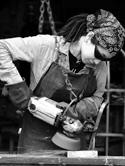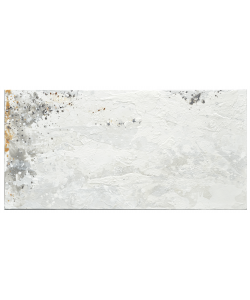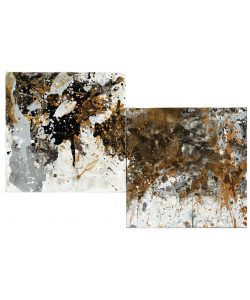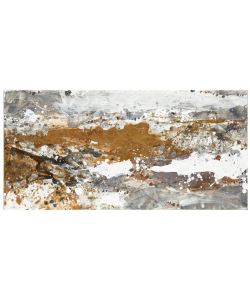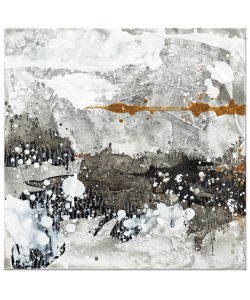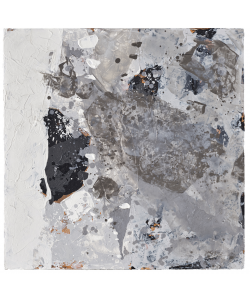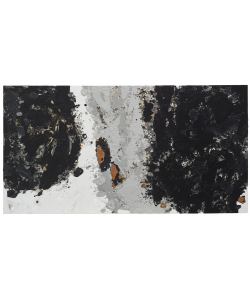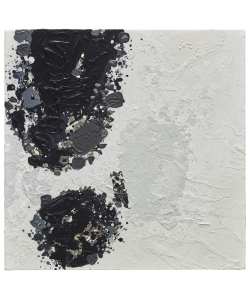Artists|藝術家
龎銚 / Pong, Yolanda(1973~ )沒有描述,捨棄形體,我只追求繪畫裡最本質的精神 |
|---|
沒有描述,捨棄形體,我只追求繪畫裡最本質的精神
在這個多元快速的時代裡,我還是老老實實的選擇了一種古老且接近勞動的創作方式。我喜歡感受用身體的律動,帶動手臂經由手碗,再傳達到手或手中握著的筆。不管是一條線、一個點、或一個色塊都有著一種活生生的形態。
繪畫對我言很直接,有時簡單直接到如同像回到孩童時的單純,而這也是我希望和繪畫之間的一種互動。我不想強加太多自我主觀的情緒,或寫實具體的形象於畫面上。在我的作品裏,我希望回歸到繪畫最原始的狀態,用最基本的繪畫語言,如點、線、面、非具象的符號色塊、筆觸、物件、媒材去架構和層疊出一個有厚度的空間。個人的情感和記憶,經由在創作的過程中和畫面的互動而被記錄下,理性的平衡一直藏在作品的裡層,而感性則作為敘述的手法。
我以時間作為一個線性的主軸,展出三到四年不等的作品。如果單一的作品是呈現了作者當下的某一種視點,那麼把不同時間年代,不同尺寸大小,不盡相同敘述方式的作品,以高低錯落不規則的方式呈現在一起,形成一定的量體,希望所營造出的視覺語言會是一種時間性的。而在不同的場域和空間中展出,會有不同的作品和排列方式,藉此分別出不同量體之間的「消減」或「增生」,就像一個生命體的成長與凋萎。我希望經由呈現方式的不同,讓觀者看到的不只是很多不同的作品,而是一件具有增減和互動的大型作品。她可以被單獨觀看,也可被視為某一個部分或時間的片段。讓過程和流動的時間填補了作品和作品之間的空隙。
在近兩年的新作品中,色彩比以往明亮些,放棄了一些略大的物件,不過卻加入了更多的金屬色,筆觸和肌里也趨於更厚重和活潑的方式呈現。符號上多了一些小的細線條和不歸則形,取代了前兩年大量的方形。當然,鐵釘仍是我最喜歡的符號之一,釘在線條的尾端,它像是一個頓點或句號,一虛一實、亦實亦虛,透過這個釘釘鑿鑿的動作,讓畫面有了更鮮明而屬於勞動的記號。
My Works
No attention to detail, abandoned all structure, I only pursue the essential spirit of the painting.
In this high-speed, multifaceted era, I have still sincerely sought out an ancient, labor-related creative style. I enjoy feeling the laws of the human body as it spurs on my arm all through my wrist, transmitting this feeling to my hand, or to the pen in my hand. Whether it’s a line, a dot, or a colorful shape, it all embodies a lively spirit.
Painting to me is very simple and direct, sometimes simple enough that it takes me back to the innocence of childhood—and this is just the kind of interactive relationship I want with painting. When painting, I don’t want to force too much of my own subjective mood into it, or put in something that’s too real or concrete. In my works, I wish to return to the most primitive state of painting, and to use the most primitive language for every dot, line, surface, abstract symbols and shapes, brushstroke, object, or medium used to construct a space with depth. In the process of creating and interacting with the image, my personal feelings and memories are recorded—rational balance always hidden within the interior layers, using emotion as my narrative technique.
I use time as a linearaxis, exhibiting three to four years of pieces. If any one of my pieces is able to show my mood at the time, then different pieces of different years, of different sizes, and of different styles put together in a haphazard, random fashion will embody a certain form, as I hope what I’ve created will take on a temporal aspect. Works exhibited in different areas or different spaces will have different arrangements, thereby distinguishing between reduction and growth, just like the growth and withering of a living body. I hope through a different style I will allow the audience to see not only many different pieces, but to also see it as one, large-scale piece with both depth and life, as my pieces can be seen individually, or be seen as a piece of a larger work, or even a segment in time. The process and the flow of time have filled in the gaps between my pieces.
My pieces within the last two years have become brighter, and I have abandoned some rather large objects. Instead I have used more metallic colors in my paintings, and my brush strokes have become wider and livelier. Now there are more small, fine lines above my symbols, and irregular forms have replaced the abundant square forms used two years ago. Of course, the iron nail still remains one of my favorite symbols. Nailed to the end of a line, the iron nail is like a stopping point, or period, one virtual one concrete, sometimes false sometimes true, emerging through this hammering motion, giving the image a brighter and more labor-related character.
1973 生於北京
1980 定居香港
1987 定居台北
1992 私立復興商工美工科繪畫組畢業
1995 畢業於國立台灣藝術專科學校美術科西畫組
1999 獲第13 屆南瀛美展南瀛獎,台南縣政府文化局
2000 龎薰琹三代九人藝術展,上海國際藝術節
2001 個展,台北華藝藝術中心
2002 畢業於美國密蘇里州芳邦大學(Fontbonne University) 藝術碩士(M.A)
2003 典藏南瀛獎16 歲,台南縣政府文化局
時間的刻度—台灣美術戰後50 年作品展,長流美術館
2004 畢業於美國密蘇里州芳邦大學(Fontbonne University)美術創作碩士(M.F.A)
2006 個展,台中由鉅藝術中心
2008 女性藝術創作之美特展—南瀛獎女性得主聯展,台南縣政府文化處
繪畫與我的距離—龎銚( 瑤) 創作展,壢新藝術生活館
上海藝術博覽會
2009 個展,上海King Space 藝術中心
上海藝術博覽會
2010 第2 屆台北國際當代藝術博覽會(YAT)
個展,上海多倫現代美術館
個展,上海King Space 藝術中心
上海藝術博覽會
第8 屆台灣設計博覽會
2011 第3 屆台北國際當代藝術博覽會(YAT)
藝術的傳承與昇華—家族展,北京畫院美術館
個展,香港海港城美術館
上海藝術博覽會
台灣當代設計師聯展,台灣國際設計博覽會
2012 個展,台北赤粒藝術
龎銚.藝術美學展-繪畫與金工飾品的對話,學學文創志業
2013 在台灣的龎氏家族,北京Art China 中國國際文化藝術博覽會
閱讀X 小畫,台北松菸誠品
迷中謎,台中AAM 精銳美術館聯展
2014 2014龎銚作品展—視覺的符號與溫度繪畫的平衡與純粹,國立國父紀念館
現任國立台灣藝術大學兼任講師
作品典藏
中國美術館/ 上海多倫現代美術館/ 台灣、上海、香港等地
Yolanda Pong
1973 Born in Beijing
1980 Settled in Hong Kong
1987 Settled in Taipei
1992 Graduated from Painting Group, Department of Arts and Craft, Fu-Hsin
Trade and Arts School
1995 Graduated from Western Painting Group, Department of Fine Arts,
National Academy of Arts
1999 Awarded Nanying Prize, the 13th Nanying Fine Arts Exhibition, Cultural
Affairs Bureau, Tainan County Government
2000 Three Generations of the Pang X unqin Family, Shanghai International Art
Festival
2001 Solo Exhibition at Airiti Art Center, Taipei
2002 Graduated with M.A. Degree from Fontbonne University, Missouri, USA
2003 Sixteen Years of Nanying Prize Collection, Cultural Affairs Bureau, Tainan
County Government
The Inscription of Time: Fifty Years of Art in Postwar Taiwan, Chan Liu Art
Museum
2004 Graduated with M.F.A. Degree from Fontbonne University, Missouri, USA
2006 Solo Exhibition at GSR Gallery, Taichung
2008 The Beauty of Female Art: Nanying Prize Female Winners Exhibition,
Cultural Affairs Bureau, Tainan County Government
Distance between Painting and Me: The Art of Pang Yao(Yolanda Pong), Li
Shin Gallery
Shanghai Art Exposition
2009 Solo exhibition at King Space, Shanghai
Shanghai Art Exposition
2010 The 2nd Young Art Taipei
Solo exhibition at Shanghai Duolun Museum of Modern Art
Solo Exhibition at King Space, Shanghai
The 8th Taiwan Design Expo
2011 The 3rd Young Art Taipei
The Continued Tradition and Sublimation of Art—Household Exhibition,The Art Museum of Beijing Fine Art Academy
Personal Art Exhibition Hong Kong, Gallery by the Harbour
Shanghai Art Exposition
Taiwan International Design Exposition
2012 Solo exhibition at Red Gold Fine Art, Taipei
Yolanda Pong Solo Exhibition: The Dialogue between Paintings and
Metalwork Jewelry, Xue Xue Institute, Taipei
2013 The Pang Family in Taiwan, Art China, Beijing
Reading X Painting, Eslite Spectrum Songyan Store, Taipei
Riddle My Riddle Group Exhibition Part I, Art & Arch Museum, Taichung
2014 Yolanda Pong's Exhibition - Visualizations of Temperature and Symbols, A
Painting's Balance and Purity, National Dr. Sun Yat-sen Memorial Hall
Instructor at National Taiwan University of Arts
Works collected by National Art Museum of China, Shanghai Duolun Museum of
Modern Art, and by private collectors in Taiwan, Shanghai, Hong Kong, etc.
1980 定居香港
1987 定居台北
1992 私立復興商工美工科繪畫組畢業
1995 畢業於國立台灣藝術專科學校美術科西畫組
1999 獲第13 屆南瀛美展南瀛獎,台南縣政府文化局
2000 龎薰琹三代九人藝術展,上海國際藝術節
2001 個展,台北華藝藝術中心
2002 畢業於美國密蘇里州芳邦大學(Fontbonne University) 藝術碩士(M.A)
2003 典藏南瀛獎16 歲,台南縣政府文化局
時間的刻度—台灣美術戰後50 年作品展,長流美術館
2004 畢業於美國密蘇里州芳邦大學(Fontbonne University)美術創作碩士(M.F.A)
2006 個展,台中由鉅藝術中心
2008 女性藝術創作之美特展—南瀛獎女性得主聯展,台南縣政府文化處
繪畫與我的距離—龎銚( 瑤) 創作展,壢新藝術生活館
上海藝術博覽會
2009 個展,上海King Space 藝術中心
上海藝術博覽會
2010 第2 屆台北國際當代藝術博覽會(YAT)
個展,上海多倫現代美術館
個展,上海King Space 藝術中心
上海藝術博覽會
第8 屆台灣設計博覽會
2011 第3 屆台北國際當代藝術博覽會(YAT)
藝術的傳承與昇華—家族展,北京畫院美術館
個展,香港海港城美術館
上海藝術博覽會
台灣當代設計師聯展,台灣國際設計博覽會
2012 個展,台北赤粒藝術
龎銚.藝術美學展-繪畫與金工飾品的對話,學學文創志業
2013 在台灣的龎氏家族,北京Art China 中國國際文化藝術博覽會
閱讀X 小畫,台北松菸誠品
迷中謎,台中AAM 精銳美術館聯展
2014 2014龎銚作品展—視覺的符號與溫度繪畫的平衡與純粹,國立國父紀念館
現任國立台灣藝術大學兼任講師
作品典藏
中國美術館/ 上海多倫現代美術館/ 台灣、上海、香港等地
Yolanda Pong
1973 Born in Beijing
1980 Settled in Hong Kong
1987 Settled in Taipei
1992 Graduated from Painting Group, Department of Arts and Craft, Fu-Hsin
Trade and Arts School
1995 Graduated from Western Painting Group, Department of Fine Arts,
National Academy of Arts
1999 Awarded Nanying Prize, the 13th Nanying Fine Arts Exhibition, Cultural
Affairs Bureau, Tainan County Government
2000 Three Generations of the Pang X unqin Family, Shanghai International Art
Festival
2001 Solo Exhibition at Airiti Art Center, Taipei
2002 Graduated with M.A. Degree from Fontbonne University, Missouri, USA
2003 Sixteen Years of Nanying Prize Collection, Cultural Affairs Bureau, Tainan
County Government
The Inscription of Time: Fifty Years of Art in Postwar Taiwan, Chan Liu Art
Museum
2004 Graduated with M.F.A. Degree from Fontbonne University, Missouri, USA
2006 Solo Exhibition at GSR Gallery, Taichung
2008 The Beauty of Female Art: Nanying Prize Female Winners Exhibition,
Cultural Affairs Bureau, Tainan County Government
Distance between Painting and Me: The Art of Pang Yao(Yolanda Pong), Li
Shin Gallery
Shanghai Art Exposition
2009 Solo exhibition at King Space, Shanghai
Shanghai Art Exposition
2010 The 2nd Young Art Taipei
Solo exhibition at Shanghai Duolun Museum of Modern Art
Solo Exhibition at King Space, Shanghai
The 8th Taiwan Design Expo
2011 The 3rd Young Art Taipei
The Continued Tradition and Sublimation of Art—Household Exhibition,The Art Museum of Beijing Fine Art Academy
Personal Art Exhibition Hong Kong, Gallery by the Harbour
Shanghai Art Exposition
Taiwan International Design Exposition
2012 Solo exhibition at Red Gold Fine Art, Taipei
Yolanda Pong Solo Exhibition: The Dialogue between Paintings and
Metalwork Jewelry, Xue Xue Institute, Taipei
2013 The Pang Family in Taiwan, Art China, Beijing
Reading X Painting, Eslite Spectrum Songyan Store, Taipei
Riddle My Riddle Group Exhibition Part I, Art & Arch Museum, Taichung
2014 Yolanda Pong's Exhibition - Visualizations of Temperature and Symbols, A
Painting's Balance and Purity, National Dr. Sun Yat-sen Memorial Hall
Instructor at National Taiwan University of Arts
Works collected by National Art Museum of China, Shanghai Duolun Museum of
Modern Art, and by private collectors in Taiwan, Shanghai, Hong Kong, etc.
冬 Winter龎銚 Pong, Yolanda90x45cm |
| Price on Request |
|---|
秋龎銚 Pong, Yolanda90x45cm |
| Price on Request |
|---|
夏龎銚 Pong, Yolanda90x45cm |
| Price on Request |
|---|
春龎銚 Pong, Yolanda45x45cm |
| Price on Request |
|---|
初雪 Early Snow龎銚 Pong, Yolanda65x65cm |
| Price on Request |
|---|
點石成金系列之九 Black Stone Turned to Gold No.9龎銚 Pong, Yolanda190x100cm |
| Price on Request |
|---|
墨點 Ink dots龎銚 Pong, Yolanda65x65cm |
| Price on Request |
|---|
龎銚的藝術和藝術道路是另一種經驗
龎均
龎銚早已不是一個學藝術的學生,亦不是一個只會畫畫的畫家。她已是一位成熟的、有個性的藝術家。在兩岸新生代中,她可稱為是位很有天才的奇女子,此言一點也不過分,不管你信不信,讓未來的歷史來證明。
她是早已走進歷史的臺灣國立藝專的末代學子,在學校她並不愉快,只要她的油畫習作色彩好一點,師長會褒貶:「妳太像妳爸爸了!」她的素描習作,上學年是九十幾分,下學年卻被師長挑出來做為最壞的範例,要全班討論。從此她翹課一學期。期末眼看她只用兩分鐘在MBN素描紙上「畫」,一張是驚嘆號「!」,一張是問號「?」,做為期末作業。老師問:「妳要幾分?」回答是:「60分就好」。對此事,我沒有絲毫指責她,我做為在兩岸三地已有四十多年教學經驗的老師,就撰寫了一本小冊子,讚揚龎銚的成熟:已是一顆有主見的藝術種子。出版印刷發給全校的教授好友,也是我對呆板和門戶霸道教育方式的不滿。後來才得知這是一位剛從法國留學回來的青年老師,內心亦深感抱歉。當龎銚考本校研究所口試時,教授說:「妳不必考研究所已經可以做藝術家了。」因此而落榜,欲哭無淚。第二年當她考師大美研所,考題是:一段古文、一首《鐵達尼號》電影樂曲、一支芭蕉葉,她提前二小時畫完一幅抽象畫,結局是:兩位教授給95分,一位教授只給30分,就此扼殺了一位青年的學習前途。對於這樣無標準的教育與環境,她生氣了,去到美國求學。在機場送行時,她只對爸爸、媽媽說了一聲「再見」,頭也不回地上了飛機。
在美國學習三年,取得兩個學位。第二年她認為向老師學畫,沒有什麼可學,就向牛仔教授學習金屬工藝,冬天在室外冶煉二千度以上的金屬,打鐵、切割、沖壓、剉磨等等,十幾位學生吃不了苦,只留下三、五位。龎銚堅持到畢業,深愛上了鋼與鐵和鐵器工具,這也是她的平面繪畫中用釘子、以鐵絲代線、有鉗子等等的由來。她的學習在逆流中成長,使她變得堅強、成熟、有主見。她的眼睛對藝術的好壞標準不是崇拜「名氣」的,她對世界著名的大藝術家也私下批評「看來修養不夠」、「火氣」。但在畢卡索美術館,卻讚嘆說:「天才就是天才,隨便一動手,作品就有趣、有靈氣。」她已理解到藝術中一個深刻的問題:就是「修養」而不是技術性功夫與表面形式。正如她爺爺龎薰琹生命最後階段、臨終前留言:「……確實有些人很有才能,不過我想到藝術修養方面比較差。」「歐美的一些畫家作品……也同樣想到藝術修養差」。看來第三代的龎銚已經理解到這樣一個藝術中的藝術問題。
她剛走出學校的大門,青春期的叛逆、感情的多種複雜與痛苦,作畫已經不追求表面技巧與形式而只想發洩情緒,她的處女作〈人體組畫〉獲得了1999年油畫南瀛獎(33屆)。拿了高額的獎金後就去了希臘。她從希臘到埃及,從美國到法國,從土耳其到西班牙、捷克等,但她對名勝景點照相並無興趣,而是尋寶般地看古蹟、文化、藝術,遊走於博物館。在亞洲,去上海、北京、西安、五台山等地。關心的是古文物。東西方文化豐富了她的藝術靈感與語言。
要特別提到的是她在近年偶然被邀請主持電視節目《龐銚敲敲門》,這個有趣而影響很廣的節目,用意是訪問、講解建築與室內裝飾的藝術元素。走遍了臺灣的北中南,訪問無數有才華的留學各國、具有新概念的建築藝術家,這是她不可多得的營養與收獲,無心插柳柳成蔭,得到了2011年電視綜合節目主持人「金鐘獎」。她穿了一身普通的、千穿百孔的牛仔褲,陌生人上了領獎台,令眾多的、資深的、俊男美女跌破了眼鏡。當名製作人邀請她主持其他節目和拍廣告時,她謝絕了。藝術還是她的不歸路。
藝術家應該是寂寞的、低調的、絕不是場面上的人物,龎銚做到了,這也是龎氏家族的家風,一貫蔑視有虛無實地露面、做秀和過度包裝。
2013年她獲得中國設計業十大傑出青年獎,她從北京回來說:「大陸只靠『內需』就很容易有極大成就,每人一開口就是做了價值幾十億的事,我什麼都沒有,只談理念、做點有關社會公益的事。但是大陸仍然是封閉的,離世界先進觀念差距甚遠。」
在大陸精選出全國三十位精英中,經過理論「PK」、龎銚獲得了前十名。她是唯一的臺灣代表。但她自己把這一切看得很平淡,說「這實在不算什麼」,獎座也丟放在家中,揚長而去。
本文之所以頗費篇幅提及以上瑣事,只想證明藝術家的形成和出現,絕不能只靠畫筆與畫布的單一關係,更不是依賴外力,靠財團投資作商業性之包裝。學校的幾本「教科書」和講義,亦無決定性之作用。龎銚在幼年還受過專業嚴格的鋼琴與芭蕾舞訓練,對她而言只是多了一份難得的修養,對姊妹藝術有所理解與興趣。由此可見,她人生道路的每一步,無論好壞都很有意義,就形成了現在的她,她的畫路與風格,亦是自然而成,正如她爺爺所說:「路就是這樣走過來的」。
如今龎銚的藝術,是以複合媒材、抽象的形式表現她所要追求的美感和美學概念。在理論上,她提出了一個美學以前從未有過的繪畫「新元素」,即「生命性的溫度」和「哲學性的平衡」,她認為這是藝術真正的「純粹」。這是一個很有價值意義的「發明」。因為這樣,她把抽象概念提升到了另一個高度和境界,這也是中國文化精華的核心,藝術即人,人即藝術。可以預感:這一立論,將對未來東方藝術產生巨大影響,因為它超越了或「寫實」或「抽象」或「寫意」或「印象」等等任何「形式概念」,回歸到人與藝術自然相關的根本。
空玩「材料」與「形式」的時代應該過去!藝術玩家充其量還是一個「玩家」。
有一句大概算是當代名言,即「當代藝術太難了,不如讓它好玩一點」,這是一種很容易被俗人接受的「好似有理,實為歪理」。藝術可能是從玩開始的,但不能以玩而結束。玩世不恭不是藝術家,耗費巨額資金、浪費了社會成本,甚至破壞了自然資源,只為了做一件遊戲式的好玩事情,這就叫「藝術」?玩得太過分了!按照中國幾千年的傳統文化,藝術是思想的、感情的、高尚的、有境界的。它不是娛樂、玩鬧、賣藝取樂,藝術是一種不朽的精神文化和有歷史價值之財富。「創造性」與「出怪招」風馬牛不相干。
龎銚生長在一個有文化歷史的嚴肅的藝術家庭,她長大了,有意無意或並不自覺地接受了她爺爺的藝術修養,今天看她的作品,是用「理性」、「思考」與「感性」結合,追求作品藝術語言的「純粹性」,這同她爺爺真是不謀而合。中國最傑出的翻譯家、文學家、美術評論家、第一位藝術展覽策劃人傅雷,他最讚賞的中國第一代現代藝術家,就是龎薰琹。他是這樣評論的:「他把色彩作緯,線條作經,整個的人生作材料,織成他花色繁多的夢。他觀察、體驗、分析如數學家,他又組織、歸納、綜合如哲學家,他分析了綜合,綜合了又分析,演進不已;這正因為生命是流動不息,天天在演化的緣故。」
「他以純物質的形和色,表現純幻想的精神境界,這是無聲的音樂。形和色的和諧,章法的構成,它們本身是一種裝飾趣味,是純粹繪畫。」
「他變形,因為要使『形』有特種表白,這是Deformisme expressive。要給予事物以某種風格,因為他的特種心境需要特種典形來具體化。」八十二年前老一代的學者專家對現代藝術的創作理念與方法有深刻的認識,深知在形式後面的內涵應該如何進行創作行為。遺憾的是,後來人很少省思,迷戀於表象的用筆、用色,似乎一蹴可幾,卻一蟹不如一蟹。長期以來,冷觀龎銚創作之路倒是相反,非常符合前輩所言。她的畫面看似簡單,但畫畫很慢,還不是一般地慢。曾經問她:「這麼簡單的畫面,怎麼還沒畫完?」回答是:「哪有這麼簡單!很多地方要考慮,有許多細部要調整、要處理。」她以嚴肅的態度十分冷靜地梳理、提煉自己的情感,達到純粹繪畫的價值。實際她的畫面只有黑白兩大塊,讓色彩極致簡單地回歸到中國哲學的陰與陽。畫黑白並不容易,黑與白不是「素描」,而是色彩的最高境界,這是從中國繪畫哲學中延伸出的色彩概念,即「墨分五色」。不但如此,白亦要「白分五色」。黑中有無窮的微差,白中亦有無窮的微差,這必須有高度敏感的「灰階」元素,色彩感覺不好是做不到的。當龎銚的作品出現在北京展廳時,許多學者讚揚她「作品充滿了文人氣質」。她之所以能做到,是因為她的創作過程,把「用筆」、「覆蓋」、「厚薄」、「乾濕」、「流動」、「肌理」、「點線」、「皴擦」、「拍揉」、「顫滾」、「逆轉」、「輕拖」、「彈拉」等各式技法均靠自己情緒之波動,經自己的手傳達於畫面,而不是尋找千奇百怪的物品替代自己的手,如廚房的鐵刷子、鋼絲團、木梳、水泥抹刀、噴槍、轉印等等,使作品「工具化」,失掉「人性化」、「感情化」,只留工具刮痕效果和毫無意識地堆砌,貌似技巧高超,可以欺俗目,而不能邀真賞。龎銚從來不用此類手段,取得所謂「技巧性效果」。龎銚提出了「符號的溫度」這一概念,這是非常有趣的。廿世紀以來,有許多西方成功的藝術大師,他們都在向東方水墨畫學習,進入了繪畫的「黑白時代」,例如馬查威爾、蘇拉琦、克萊因都有過很成功的黑白作品。
馬查威爾的代表名作〈西班牙共和體的輓歌〉,我在作品前看了很久,它的構圖、造形、布局,黑白比例都令人有耳視目聽之感,具有新的視覺震撼,很有力!但並沒有「溫度」之感,是冷冰冰的一種形式。大部分西方藝術家的黑白現代畫,距中國古文人所要求之境界還差得很遠,正是初見佳,久視亦不覺其厭,但並非其佳處為人所不能到,亦非與人以不易知,用筆乃屬平淡,故,是為中品非為上品。
如上所述:黑色非黑,要有墨韻,因此「溫度」說也是「氣韻」說。有溫度才有氣韻,有氣韻必有溫度。
視覺符號不是一個單一的設計性造形,而是要有氣韻、要有生命,這就難上加難了。難怪龎銚作畫是如此地慢,她思考多於下筆,下筆是一時的,思考是漫長的。她要在濃中求淡,又在淡中見濃;要在塊面中有線,又要以線積面;要在厚中見薄,又要薄中有厚;亮中有烏,烏中有亮;大點小點遊走於不同的灰塊與黑白之中。這一切如同不可知的宇宙運行一般形成生命與活力。巴哈的十二平均律就是如此,在有限的音階中表現無限豐富的旋律與宇宙相接,成為人類最高尚的音樂。
當繪畫走向簡單與單純,又在單純中有無限微妙的豐富變化:「黑白」、「灰階」、「點線」、「疏密」、「空間」取得了最佳平衡,即是最完美的純粹繪畫元素。徹底擺脫了題材的世俗性,而超然獨立存在。這種繪畫的精神性,如同「氣韻」,不是什麼語言,而是「人性」、「生命」、「情緒」、「情感」、「靈性」、「活力」、「衝動」、「理性」、「意念」、「幻覺」、「動感」、「安祥」、「悲歡離合」,綜合為氣之韻。
中國自古繪畫哲學講求「神似」、「神韻」、「妙趣」。「妙」字最為重要,唯有豐厚修養才可達。西方的普世玩藝術只停留在材料大拼貼、堆積「大勞作」,怪誕不經地「創新」、不可名狀地不求甚解。龎銚卻走在另一條路上,只求單純的境界與美感。畫以人重,藝由道崇。
黃賓虹曰:「庸史之畫有二種:一江湖,一市井。此等惡陋筆墨,不可令其入眼。因江湖畫,近欺人詐嚇之技而已,市井之畫,求媚人塗澤之工而已。」
晉顧愷之曰:「有一毫小失,則神氣與之俱變矣。」
唐張彥遠曰:「以形似之外求其畫,此難與俗人道也。」
明董其昌曰:「氣韻不可學,此生而知之,自然天授。」
清方薰曰:「氣韻生動為第一義。然必以氣為主。氣盛則縱橫揮灑,機無滯礙,其間韻自生動矣。杜老云:『元氣淋漓幛猶濕。』是即氣韻生動。」
龎銚就是龎銚。道路漫長而光明。
結語
藝術家與理論家談創作之角度與立場顯然有別。理論家喜歡以「歷史學」、「社會學」、「政治學」、「哲學」、「統計學」去評論「藝術」。然,藝術家是普通的凡人,是很實際的,多半重技法,從美學、真善美出發,甘願身安澹泊,曲高和寡,知希為貴,不談空玄理論。
寫龎銚尤甚為難,試筆撰文,請見諒。
2014年6月台北
An Art Road Paved by Other Experiences: Pang Yao's Art and Art Career
Pang Jiun
Pang Yao is no longer an art student, and nor is she a painter whose life is circumscribed by painting. She is a mature and self-assured artist. To say that she is a gifted and extraordinary figure among the younger generation of cross-strait artists is not an exaggeration. Believe it or not, history will prove it.
As one of the last graduates of the long-gone National Academy of Arts, she was not a happy student, because her better color studies were criticized as "resembling your father's works too much!" When she learned that her sketches were cited as the worst examples in the class discussion, she skipped the class to the end of the semester, despite that she had scored over 90 in the first semester. At the end of the second semester, as her teacher asked her what grade she wanted for the exclamation mark '!' and question mark '?' she painted on the MBN sketching paper in two minutes as her end-of-semester work, she replied, "60 will be fine." I have never scolded her for the event. As a teacher having over forty years of teaching experience in China, Taiwan, and Hong Kong, I only wrote a pamphlet praising Pang Yao's maturity as a strong-minded artist-to-be, while expressing my discontent with the rigid, hierarchical, and domineering educational system, and handed the published copies to the professors and friends in the academy. It was later that I learned that the teacher in question was a young professor recently returned from France, and I felt terribly sorry for him. Pang Yao was dumbfounded and failed the oral examination to the graduate school of the academy when the examiner commented that "You don't need the master's degree to be an artist." The following year, she turned to the M.A. program of the Department of Fine Arts, National Taiwan Normal University. In response to the question bringing together a paragraph of an ancient text, a track from the movie Titanic, and an image of a plantain leaf, she finished an abstract painting two hours before the examination ended. However, that she scored 95 from two professors but only 30 from the third professor put an end to her academic aspirations. Angry at the nonsensical grading system and educational environment, she left for the United States. Before she boarded the plane without turning her head, her parents received only a brief 'Goodbye.'
She received two degrees in the three years in the United States. In her second year there, she turned to study metal craft from a 'cowboy professor,' for she thought that nothing more could be learned from her painting teacher. The hardship of forging, cutting, pressing, filing, and casting metal outdoors in over 2000 degree in winter cut down the number of students from over a dozen to less than five. As one of those who persisted to the end of the semester, Pang Yao has henceforth developed a passion for steel, iron, and metal tools. It also explains why she uses nails, irons wires (in place of lines) and pincers in her graphic works. Her career unfolds in adversity makes her strong, mature, and independent. Rather than evaluating an artwork based on fame, she often criticizes the world-famous artists as "lacking cultivation" or "too impulsive" in private. However, she was very respectful in Museu Picasso, "Genius is genius. Whatever he does, there is pleasure and spirit." These words reveal an advanced understanding of art: she had perceived that 'cultivation' is more vital than technical expertise and formal surface. They echo her grandfather Pang Xunqin's last words,"...Some of them are indeed highly talented, but in my view, they are poorly trained." "The European and American painters... are likewise poorly trained." As a member of the third generation of the Pang family, Pang Yao seems to have arrived at the core question of art.
In the first days after she left the academy, teenage rebelliousness and emotional complexities and pains had steered her away from pursuing technical and formal perfection towards self-expression. Her first public work "Human Body Series" painted at this period won the 33rd Nanying Award in Oil Painting in 1999. As soon as she received the high prize money, she flied to Greece, and then Egypt, America, England, Turkey, Spain, and Czech, of which her interest was more in touring through historical sites and cultural and art museums than taking photographs in tourist spots. Her visits to Shanghai, Beijing, Xi'an, and Mount Wutai also gravitate towards trips to ancient cultural relics. Both Eastern and Western cultures have inspired and enriched her artistic language.
Notably, she was also invited by chance to host "Pang Yao Knocks," an interesting and influential TV program organizing interviews with accounts of the aesthetic elements of architectures and their interior design. The exceptionally edifying and rewarding experience of traveling around and interviewing countless talented, innovative architects who had studied abroad won her the title of 'Best Host in a Comprehensive Programme' in the 2011 Golden Bell Awards. How she startled the glamorous senior participants, to whom she had been a stranger, when she walked up on the stage in plain ripped jeans! Later, she turned down a famous producer's offer of other TV programs and commercials. Art is her chosen career.
Artists should be solitary and low-key, away from being showy. Pang Yao achieves this by demonstrating our family spirit that looks down on vainglory, pretensions, and mannerism.
In 2013, she was selected asone of the "Ten Outstanding Youth" in design industry in China. As she said after she returned from Beijing, "In China, it is easy for one to thrive merely on 'domestic demand,' to accomplish something worth billions of dollars. By contrast, I have nothing but my ideal to contribute to public welfare. Nevertheless, China is by and large conservative; it is still way behind the developed countries."
Although Pang Yao as the only candidate from Taiwan was chosen into the top ten from thirty elites representing different areas of China after fierce competition, she downplayed the achievement by a brief comment that "It is nothing," before she left the trophy at home and went away.
The lengthy chronicling of Pang Yao's career is meant to prove that the style and rise of an artist cannot be ascribed solely to the movement from paintbrush to canvas, much less to commercial buildup from financial groups; the influence of textbooks and the few teaching materials are also limited. Pang Yao had received strict professional training in piano and ballet in her childhood, but they serve only as additional experiences which strengthen her knowledge of and interest in sibling categories of art. Every step of her life is evidently meaningful to her. For better or for worse, they have shaped the way she is. Her career and style develop as naturally as what her grandfather had described, "It is how I become what I am today."
Today's Pang Yao uses mixed media and abstract shapes to convey the beauty and aesthetics she has been questing after. 'The temperature of life' and 'philosophical balance' as the hitherto unheard-of ideas in painting are, in her opinion, the genuine indicators to 'pure art.' They are valuable 'inventions,' which elevate her abstract concepts to a new height, a fresh state, and grant her access to the innermost core of Chinese culture. Art is who creates it. Transcending the formal concepts of realism and abstraction, expressionism and impressionism, while returning to the quintessential question of art in relation to human and Nature, they are predictably influential to the development of Eastern art.
The fashion of playing on 'medium' and 'form' should be over! At their best, art players are still 'players.'
"Contemporary art is too difficult, it is better to make it more fun." Possibly ranked as a famous saying today, the generally-accepted argument has a fallacious reasoning. Art may originate from games, but it cannot be perfected by games. Frivolousness is not art; moreover, it may cost the society dearly, and even be detrimental to natural recourses. How could it be 'art' when the work is nothing more than a game-like plaything? It is totally unacceptable! In Chinese culture spanning thousands of years, art is metaphysical, emotional, noble, and spiritual. It is not entertainment, rollicking, or any commercial amusement, but a projection of cultural spirit and an insatiable, historically significant wealth.
Brought up in a family with a serious concern for cultural and art cultivation, Pang Yao has matured, and has consciously or subconsciously absorbed her grandfather's concept of art. Her recent works integrating 'reason,' 'contemplation,' and 'sensibility' in their pursuit of a 'pure' language of art mirror those of her grandfather's. Pang Xunqin is the most admired first-generation modern Chinese artist by Fu lei, the most outstanding translator, writer, art commentator, and the first curator of art exhibition in China. Here is his comment on Pang Xunqin, "Coordinating colors and lines and taking life as his subject, he weaves dreams of colorful diversity. He observes, experiences, analyzes as a mathematician, and organizes, deduces, and summarizes as a philosopher. His career evolves as he analyzes and summarizes, summarizes and analyzes. It indicates how life flows endlessly, and changes everyday."
"He expresses the imaginary landscape of the mind with the forms and colors of pure substance. It is soundless music, where the harmony of forms and colors, the arrangement of elements, gives off a decorative glow. It is pure painting."
"He deforms to give particular expression to 'compositional elements.' This is 'expressive deformism,' which endows the elements with a style to embody his state of mind with particular models."
These words from eighty-two years ago displays the senior scholar's profound understanding of the concept and method of modern art, a full consciousness of how content is embodied in form. Unfortunately, the later generation fascinated by brushwork and colors reflects less and less on the subject, and their fast achievement discloses fewer and fewer cultivation. By contrast, Pang Yao's career suggests an affiliation with the descriptions in an objective and long-term observation. Her seemingly simple painting surface costs her an unusually colossal amount of time. "Why does it take so long for so simple a composition?" I once asked her. "It is not simple at all! I have plenty to think about, tons of details to consider and handle." She cool-headedly sorts out and purifies her feelings to attain the goal of pure painting, though in fact there are only black and white on her canvas. As Yin and Yang in the Chinese culture, they act as the origin of colors. Nevertheless, it is not easy to present black and white. That they are less the result of 'sketching' than the highest state of colors is a concept of color derived from the Chinese painting philosophy. As much as there are "five colors of ink,' there are 'five colors of white.' The infinite nuances of black parallel those of white. The key is to be highly sensitive to the 'grayscale,' and it requires a superb sense of color from the artist. Pang is able to cultivate the 'literary grace' praised by commentators as her works were exhibited in the Beijing galleries is because she guides the elements of brushwork, thickness, humidity, movement, texture, points and lines, texture strokes, and the skills of covering, patting and rubbing, shaking and rolling, reversing, trailing , leaping and pulling, with the shifts of her mood through her hands, instead of applying strange tools such as iron brushes, steel brushes, wooden combs, trowels, spray guns, or printing tools, which deprive art of 'humanity' and 'emotions,' relegating it to the status of an 'instrument.' The traces left by the tools and purposeless layering, though seemingly marvelous, are appealing to eyes but unattractive to the heart. Pang Yao never resorts to tricks of this sort to achieve the so-called 'technical effects;' instead, she proposes the interesting concept of 'the temperature of sign.' Many Western art masters have being learning from the Eastern ink painting since the 20th century, foregrounding the arrival of 'the age of black and white' for painting. Robert Motherwell, Pierre Soulages, and Franz Kline are some of the instances who have successful black-and-white works.
I had once stood in front of Motherwell's famous work 'Elegy to the Spanish Republic' for a long time. Its composition, figuration, arrangement, and proportion of black and white are visually stunning, powerful, and even beyond the grasp of the senses! However, it is devoid of any 'warmth;' it is cold. Most of the modern black-and-white paintings of the Western artists are far inferior to the Chinese literati paintings in terms of aesthetic depth. Their enduring beauty is not unattainable, ungraspable; their brushwork is also insipid. In short, they are good but not excellent works.
As delineated above, black possesses gradations and auras. Hence the postulation of 'temperature' implies that of 'aura.' It is warmth that generates aura, and the presence of aura implies warmth.
Visual signs are not independent elements. They are supposed to be inherent with aura, with life, and this poses difficulties for artists. It is why Pang Yao paints slowly, because she thinks intensely before she lays her hands on the canvas. Thinking is more time-consuming than painting. She seeks lightness in dense colors, and density in light colors; expresses lines in planes, and planes formed by lines; explores thinness of thick strokes, and thickness in thin strokes; excavates darkness in bright space, and brightness in dark space. Dots of various sizes are spread on gray, black, and white planes. Together, they exhume a life and energy as an inexplicable universe. It is also the way J. S. Bach composed his Well-Tempered Clavier, in which the infinite, rich rhythms expressed in finite musical scale make contact with the universe, giving birth to the noblest music in the human world.
Painting develops towards the simple and the pure has a myriad of possible nuanced changes: back and white, grayscale, point and plane, light and dense, and spatial arrangement. Pure painting is perfected by their supreme balance, which rises above the mundane and achieves transcendental independence. Like aura, the spirituality of painting is less a kind of language than a union of humanity, life, moods, emotion, spirit, energy, impulses, reason, will, illusions, movements, serenity, and life's sorrows and joys, separations and unions.
Chinese painting philosophy emphasizes 'resemblance,' 'verve,' and 'aesthetic wonder,' among which 'wonder (miao)' as the most important goal can only be accomplished by ample cultivation. The pervasive play on art in the West generates nothing more than comprehensive collages, 'large labor works,' and grotesque 'innovations, while being unspeakably shallow. Pang Yao is on another path to purity and beauty. Her paintings accentuate humanity; her art is elevated by truth.
Huang Bin-hong said, "There are two types of mundane paintings: One is uncivilized, the other folk. Both are deplorable because uncivilized paintings are nothing except deceit and intimidation, and folk paintings are nothing except enticing decoration."
Ku Kai-chih of Chin dynasty said, "Even minor deviations impact on spirit and aura."
Chang Yen-yuan of Tang dynasty said, "It is difficult to explain to laymen what we expect for painting aside from realism."
Tung Chi-chang of Ming dynasty said, "Aura is unfathomable. It is bestowed by Heaven at the moment of birth."
Fang Hsun of Ching dynasty said, "Aura (chi-yun) is fundamental, of which chi is even more pivotal. A vivaciouschi contributes to a dexterous and unrestrained pen, from which springs yun. What Tu Fu's "drenched cloth hinted at a full energy" refers to is aura."
Pang Yao is Pang Yao, whose road of art is long and bright.
Conclusion
Artists differ drastically from theorists in terms of perspective and position towards art. While theorists analyze art on the grounds of historiography, sociology, philosophy, and statistics, artists as academic outsiders are more practical. They emphasize techniques with a central concern for aesthetics, truth, goodness and beauty; they willingly cherish anonymity and solitude as a result of their spiritual height; they know what most people do not know and speak with their feet firmly rooted in reality.
It is particularly difficult for me to write on Pang Yao. I ask your forgiveness for my clumsy attempt.
June 2014 in Taipei
點、線、面的第三種閱讀----龎銚藝術的跨文化現代性 曾長生(Pedro Tseng Ph. D.)
一、龎銚的跨文化起源與過程
龎銚家族三代,第一代人龎薰琹接受國外油畫的洗禮,而第二代人龎均則是將油畫的性格內化,發展出屬於東方的油畫,第三代人龎銚則是有著新時代的表現。龎銚擁有畫家、金工藝術家、大學講師與媒體人多重身分。
說起龎銚的家族,在藝術界可都是赫赫有名,爺爺龎薰琹本來學醫,後來到法國留學時愛上藝術,成為第一代中國旅法藝術家,回到中國後擔任北京中央工藝美術學院首任院長,奶奶則是留日畫家。而龎銚的父親龎均被稱為天才兒童,18歲就大學畢業,是近代中國油畫大師徐悲鴻的關門弟子。而龎銚的母親籍虹,甚至包括姑姑、姑丈、表姊和表姊夫皆是繪畫界的重要人物,三代九人與藝術淵源深遠。
在如此顯赫的家世背景下,是否感受到眾多「矚目」與「壓力」,「其實,父親完全沒給我壓力,也沒要求我要走上這一條路,他甚至幾乎沒教過我,只丟給我紙筆隨便畫。」龎銚說。油畫大師老爸當初並不想培養出會畫畫的女兒,而是音樂家女兒。於是在舉家搬往香港時,龎均讓九歲的龎銚開始學鋼琴。龎銚的父母沒讓孩子在壓力下成長,也未曾在成績上作文章,但龎銚認為,父母的期待雖然都未說出口,但往往都是潛移默化的,像是母親從小就會讓她背唐詩宋詞,既使不懂字面上的意義,但她也覺得很有趣,所以當時背了很多,甚至還會提筆創作。
「直到進了復興美工,父親才真正教我一些炭筆素描的基礎。」龎銚說。之後,國立藝專畢業的她,卻遇到「人生撞牆期」,讓她遠離繪畫這條路,龎銚回憶道:「若要說叛逆期的話,大概就是藝專畢業後這段時間,因為我一直在思考是不是要走繪畫這條路,所以從21歲到25歲這四年,我完全拒絕畫畫,跑去學了服裝、剪裁、打版,但最後還是回到這裡。」
觀龎銚的藝術成長,正符合跨文化現代性的自發性選擇與跨文化的本質。
1、自發性的選擇
福柯(Michel Foucault)在談到跨文化現代性時,他認為,現代性的態度不是把自我的立場預設在既存秩序之內或之外,而是同時在內又在外:現代主義者總是處身於尖端,不斷測試體制權力的界線,藉此尋找踰越的可能。對他來說,這是一場遊戲,是自由實踐與現實秩序之間的遊戲。在面對體制權力時,唯有透過自由實踐,個人能動性(agency)才有可能發揮。
簡而言之,對福柯而言,現代性態度是我們自發性的選擇:是面對時代時,我們的思想、文字、及行動針對體制限制所作的測試;目的是超越其侷限,以尋求創造性轉化。試問:如果在面對權力體制時,毫無個人自由及個人能動性,革命及創造如何可能?而文化翻譯者則發揮個人能動性在跨文化場域中進行干預,以尋求創造性轉化。
2、跨文化的本質
福柯認為我們不應該忽視時間和空間之中關鍵性的交叉點,在一個文化架構中處理視覺素材,意味著發掘出視覺與時空交會現象的新方法。從今天的觀點來看,菁英文化與人類學資料,似乎都以不同的方向指向現代視覺文化,而視覺文化具有交流性與混雜性的,簡言之,就是跨文化的。
談到跨文化的本質,它並不是只發生一次的事件或者共同的經驗,而是每一代以自己的方式更新的過程。在後現代的今日,那些以往堅定地自認為居於文化核心的地方,也同樣體驗到文化的轉化過程。跨文化並非持續在現代主義的對立中運作,而是提供方法分析我們居住地充斥的混雜性(hybrid)、連結性(hyphenated)、統合性(syncretic)的全球性移民離散(diaspora)現象。
二、龎銚的後現代空間思維
龎銚表示,與父親的作品性質不同,她主要著力在複合媒材方面,不像油畫這麼具象。
1、老爸龎均「為繪畫而繪畫」:
老爸龎均歷經文化大革命時期,在那個一片紅的創作的年代,被專門指派畫風景和名勝古蹟的寫生畫,在這時候的社會條件下,藝術家的創作路程十分艱辛,對龎均而言,再現(represent)也只能呈現唯美與唯心,因此寫生便成為他與環境的初犢狀態。所以龎均的寫生、寫景,脫離當代社會的歸納與脈絡化,成了「為繪畫而繪畫」。以客觀中性、追求常駐心中對美的那份執著感動,將其投影堆疊,變為單純的追求情景、人物、靜物的色線形問題。龎均解釋稱:
「我的記憶是從三歲開始……,因為雖然我是在上海出生,但在還沒有滿月的時候,就隨父母來到了北平,因為那時候徐悲鴻在北平藝專的關係。在我還沒有滿周歲就因為戰爭被家人帶著往大後方跑,所以從我小時候就覺得生活很不安定、很動盪,沒有在一個地方好好的上學過。而我父親的繪畫系統(表現主義)跟徐悲鴻(學院寫實主義)是不同的路線的,我父親是走現代美術路線,所以才有決瀾社宣言。在三十八年以後因為父親在學術上被推為批判的位置,說他是搞形式主義,所以他從此就收筆了,不再畫圖。因為他當時也對包浩斯(Bauhaus)有興趣,所以就有理想要帶出一個設計工藝學院,但最終還是被打為右派。」
而龎銚在她的創作自述中表示: 「沒有描述,捨棄形體,我只追求繪畫裡最本質的精神,在這個多元快速的時代裡,我還是老老實實的選擇了一種古老且接近勞動的創作方式,我喜歡感受用身體的律動,帶動手臂經由手腕,再傳達到手或手中握著的筆,不管是一條線、一個點、或一個色塊都有著一種活生生的形態。」
此點可看出龎銚在創作的本質與精神上,雖深受老爸龎均「為繪畫而繪畫」之影響,不過卻是沒有描述,捨棄形體的點、線、面、非具象的符號色塊。
2、點、線、面的第三種閱讀
繪畫對龎銚而言很直接,有時簡單直接到如同像回到孩童時的單純,而這也是她希望和繪畫之間的一種互動,龎銚不想強加太多自我主觀的情緒,或寫實具體的形象於畫面上。在她的作品裏,希望回歸到繪畫最原始的狀態,用最基本的繪畫語言,如點、線、面、非具象的符號色塊、筆觸、物件、媒材去架構和層疊出一個有厚度的空間,個人的情感和記憶,經由在創作的過程中和畫面的互動而被記錄下,理性的平衡一直藏在作品的裡層,而感性則作為敘述的手法。
現代主義的空間證明只是在一個更強烈的層面上,複製了系統本身的邏輯,並且往前將它的理性化和功能主義(functionalism)精神,以及治療性的實證主義和標準化精神,轉移到尚未被夢想到的建造空間。我們只能藉著一個相關的歷史問題才能決定這些選擇。這也就是說,現代主義事實上是否已完成它的任務和計劃,或者受到干擾,而且基本上仍然是不完全的、不足的。後現代主義仍然提出另一可能性,一個像是第三種閱讀的東西。
3、時間之空間化
龎銚以時間作為一個線性的主軸,展出三到四年不等的作品。如果單一的作品是呈現了作者當下的某一種視點,那麼把不同時間年代,不同尺寸大小,不盡相同敘述方式的作品,以高低錯落不規則的方式呈現在一起,形成一定的量體,希望所營造出的視覺語言會是一種時間性的。而在不同的場域和空間中展出,會有不同的作品和排列方式,藉此分別出不同量體之間的「消減」或「增生」,就像一個生命體的成長與凋萎。她希望經由呈現方式的不同,讓觀者看到的不只是很多不同的作品,而是一件具有增減和互動的大型作品。它可以被單獨觀看,也可被視為某一個部分或時間的片段。讓過程和流動的時間填補了作品和作品之間的空隙。
某種空間的轉折,似乎為區別後現代與現代主義提供了有用的方式。此區別存在於時間和空間的相互關係的兩種形式之間,而不是存在於兩個不能區別的範疇之間。此特殊大轉型即時間之被替代與時間之空間化,其初步探索經常藉著一種失落感來記錄它的新奇性。從先前的現代主義和其時間性的觀點來看,被關注的是對深層記憶的記憶,被設定的是對於懷舊的懷舊。因此,我們必須繞行通過現代主義,以便瞭解後現代的歷史原創性和其空間論。
4、被媒介化後的反射動作
在近兩年的龎銚新作品中,色彩比以往明亮些,放棄了一些略大的物件,不過卻加入了更多的金屬色,筆觸和肌理也趨於更厚重和活潑的方式呈現。符號上多了一些小的細線條和不規則形,取代了前兩年大量的方形。當然,鐵釘仍是她最喜歡的符號之一,釘在線條的尾端,它像是一個頓點或句號,一虛一實、亦實亦虛,透過這個釘釘鑿鑿的動作,讓畫面有了更鮮明而屬於勞動的記號。
新空間美學和其存在性的生命世界的任何具體解說,都需要一些中間性的步驟,或以往辯證所稱的中介(mediation)。後現代的空間化,已經在各種空間媒體的關係和並存的異質力量之中進行了,我們在此可以將空間化說成一種傳統精緻藝術被媒介化(mediatized)的過程。這也就是說,這些傳統精緻藝術現在覺察到它們自己是一個媒體系統的各種媒介,在這個系統裡,它們自己的內在生產也構成了一個象徵性的訊息。因此,包括以前曾被稱做繪畫、雕刻、寫作,甚至建築,從一個不是媒介之上,而是在媒介關係系統之內的地方,取得它的效果,我們似乎可以更恰當地將這件事情描述成一種反射,而不是較傳統的混合媒介動作。
龎均
龎銚早已不是一個學藝術的學生,亦不是一個只會畫畫的畫家。她已是一位成熟的、有個性的藝術家。在兩岸新生代中,她可稱為是位很有天才的奇女子,此言一點也不過分,不管你信不信,讓未來的歷史來證明。
她是早已走進歷史的臺灣國立藝專的末代學子,在學校她並不愉快,只要她的油畫習作色彩好一點,師長會褒貶:「妳太像妳爸爸了!」她的素描習作,上學年是九十幾分,下學年卻被師長挑出來做為最壞的範例,要全班討論。從此她翹課一學期。期末眼看她只用兩分鐘在MBN素描紙上「畫」,一張是驚嘆號「!」,一張是問號「?」,做為期末作業。老師問:「妳要幾分?」回答是:「60分就好」。對此事,我沒有絲毫指責她,我做為在兩岸三地已有四十多年教學經驗的老師,就撰寫了一本小冊子,讚揚龎銚的成熟:已是一顆有主見的藝術種子。出版印刷發給全校的教授好友,也是我對呆板和門戶霸道教育方式的不滿。後來才得知這是一位剛從法國留學回來的青年老師,內心亦深感抱歉。當龎銚考本校研究所口試時,教授說:「妳不必考研究所已經可以做藝術家了。」因此而落榜,欲哭無淚。第二年當她考師大美研所,考題是:一段古文、一首《鐵達尼號》電影樂曲、一支芭蕉葉,她提前二小時畫完一幅抽象畫,結局是:兩位教授給95分,一位教授只給30分,就此扼殺了一位青年的學習前途。對於這樣無標準的教育與環境,她生氣了,去到美國求學。在機場送行時,她只對爸爸、媽媽說了一聲「再見」,頭也不回地上了飛機。
在美國學習三年,取得兩個學位。第二年她認為向老師學畫,沒有什麼可學,就向牛仔教授學習金屬工藝,冬天在室外冶煉二千度以上的金屬,打鐵、切割、沖壓、剉磨等等,十幾位學生吃不了苦,只留下三、五位。龎銚堅持到畢業,深愛上了鋼與鐵和鐵器工具,這也是她的平面繪畫中用釘子、以鐵絲代線、有鉗子等等的由來。她的學習在逆流中成長,使她變得堅強、成熟、有主見。她的眼睛對藝術的好壞標準不是崇拜「名氣」的,她對世界著名的大藝術家也私下批評「看來修養不夠」、「火氣」。但在畢卡索美術館,卻讚嘆說:「天才就是天才,隨便一動手,作品就有趣、有靈氣。」她已理解到藝術中一個深刻的問題:就是「修養」而不是技術性功夫與表面形式。正如她爺爺龎薰琹生命最後階段、臨終前留言:「……確實有些人很有才能,不過我想到藝術修養方面比較差。」「歐美的一些畫家作品……也同樣想到藝術修養差」。看來第三代的龎銚已經理解到這樣一個藝術中的藝術問題。
她剛走出學校的大門,青春期的叛逆、感情的多種複雜與痛苦,作畫已經不追求表面技巧與形式而只想發洩情緒,她的處女作〈人體組畫〉獲得了1999年油畫南瀛獎(33屆)。拿了高額的獎金後就去了希臘。她從希臘到埃及,從美國到法國,從土耳其到西班牙、捷克等,但她對名勝景點照相並無興趣,而是尋寶般地看古蹟、文化、藝術,遊走於博物館。在亞洲,去上海、北京、西安、五台山等地。關心的是古文物。東西方文化豐富了她的藝術靈感與語言。
要特別提到的是她在近年偶然被邀請主持電視節目《龐銚敲敲門》,這個有趣而影響很廣的節目,用意是訪問、講解建築與室內裝飾的藝術元素。走遍了臺灣的北中南,訪問無數有才華的留學各國、具有新概念的建築藝術家,這是她不可多得的營養與收獲,無心插柳柳成蔭,得到了2011年電視綜合節目主持人「金鐘獎」。她穿了一身普通的、千穿百孔的牛仔褲,陌生人上了領獎台,令眾多的、資深的、俊男美女跌破了眼鏡。當名製作人邀請她主持其他節目和拍廣告時,她謝絕了。藝術還是她的不歸路。
藝術家應該是寂寞的、低調的、絕不是場面上的人物,龎銚做到了,這也是龎氏家族的家風,一貫蔑視有虛無實地露面、做秀和過度包裝。
2013年她獲得中國設計業十大傑出青年獎,她從北京回來說:「大陸只靠『內需』就很容易有極大成就,每人一開口就是做了價值幾十億的事,我什麼都沒有,只談理念、做點有關社會公益的事。但是大陸仍然是封閉的,離世界先進觀念差距甚遠。」
在大陸精選出全國三十位精英中,經過理論「PK」、龎銚獲得了前十名。她是唯一的臺灣代表。但她自己把這一切看得很平淡,說「這實在不算什麼」,獎座也丟放在家中,揚長而去。
本文之所以頗費篇幅提及以上瑣事,只想證明藝術家的形成和出現,絕不能只靠畫筆與畫布的單一關係,更不是依賴外力,靠財團投資作商業性之包裝。學校的幾本「教科書」和講義,亦無決定性之作用。龎銚在幼年還受過專業嚴格的鋼琴與芭蕾舞訓練,對她而言只是多了一份難得的修養,對姊妹藝術有所理解與興趣。由此可見,她人生道路的每一步,無論好壞都很有意義,就形成了現在的她,她的畫路與風格,亦是自然而成,正如她爺爺所說:「路就是這樣走過來的」。
如今龎銚的藝術,是以複合媒材、抽象的形式表現她所要追求的美感和美學概念。在理論上,她提出了一個美學以前從未有過的繪畫「新元素」,即「生命性的溫度」和「哲學性的平衡」,她認為這是藝術真正的「純粹」。這是一個很有價值意義的「發明」。因為這樣,她把抽象概念提升到了另一個高度和境界,這也是中國文化精華的核心,藝術即人,人即藝術。可以預感:這一立論,將對未來東方藝術產生巨大影響,因為它超越了或「寫實」或「抽象」或「寫意」或「印象」等等任何「形式概念」,回歸到人與藝術自然相關的根本。
空玩「材料」與「形式」的時代應該過去!藝術玩家充其量還是一個「玩家」。
有一句大概算是當代名言,即「當代藝術太難了,不如讓它好玩一點」,這是一種很容易被俗人接受的「好似有理,實為歪理」。藝術可能是從玩開始的,但不能以玩而結束。玩世不恭不是藝術家,耗費巨額資金、浪費了社會成本,甚至破壞了自然資源,只為了做一件遊戲式的好玩事情,這就叫「藝術」?玩得太過分了!按照中國幾千年的傳統文化,藝術是思想的、感情的、高尚的、有境界的。它不是娛樂、玩鬧、賣藝取樂,藝術是一種不朽的精神文化和有歷史價值之財富。「創造性」與「出怪招」風馬牛不相干。
龎銚生長在一個有文化歷史的嚴肅的藝術家庭,她長大了,有意無意或並不自覺地接受了她爺爺的藝術修養,今天看她的作品,是用「理性」、「思考」與「感性」結合,追求作品藝術語言的「純粹性」,這同她爺爺真是不謀而合。中國最傑出的翻譯家、文學家、美術評論家、第一位藝術展覽策劃人傅雷,他最讚賞的中國第一代現代藝術家,就是龎薰琹。他是這樣評論的:「他把色彩作緯,線條作經,整個的人生作材料,織成他花色繁多的夢。他觀察、體驗、分析如數學家,他又組織、歸納、綜合如哲學家,他分析了綜合,綜合了又分析,演進不已;這正因為生命是流動不息,天天在演化的緣故。」
「他以純物質的形和色,表現純幻想的精神境界,這是無聲的音樂。形和色的和諧,章法的構成,它們本身是一種裝飾趣味,是純粹繪畫。」
「他變形,因為要使『形』有特種表白,這是Deformisme expressive。要給予事物以某種風格,因為他的特種心境需要特種典形來具體化。」八十二年前老一代的學者專家對現代藝術的創作理念與方法有深刻的認識,深知在形式後面的內涵應該如何進行創作行為。遺憾的是,後來人很少省思,迷戀於表象的用筆、用色,似乎一蹴可幾,卻一蟹不如一蟹。長期以來,冷觀龎銚創作之路倒是相反,非常符合前輩所言。她的畫面看似簡單,但畫畫很慢,還不是一般地慢。曾經問她:「這麼簡單的畫面,怎麼還沒畫完?」回答是:「哪有這麼簡單!很多地方要考慮,有許多細部要調整、要處理。」她以嚴肅的態度十分冷靜地梳理、提煉自己的情感,達到純粹繪畫的價值。實際她的畫面只有黑白兩大塊,讓色彩極致簡單地回歸到中國哲學的陰與陽。畫黑白並不容易,黑與白不是「素描」,而是色彩的最高境界,這是從中國繪畫哲學中延伸出的色彩概念,即「墨分五色」。不但如此,白亦要「白分五色」。黑中有無窮的微差,白中亦有無窮的微差,這必須有高度敏感的「灰階」元素,色彩感覺不好是做不到的。當龎銚的作品出現在北京展廳時,許多學者讚揚她「作品充滿了文人氣質」。她之所以能做到,是因為她的創作過程,把「用筆」、「覆蓋」、「厚薄」、「乾濕」、「流動」、「肌理」、「點線」、「皴擦」、「拍揉」、「顫滾」、「逆轉」、「輕拖」、「彈拉」等各式技法均靠自己情緒之波動,經自己的手傳達於畫面,而不是尋找千奇百怪的物品替代自己的手,如廚房的鐵刷子、鋼絲團、木梳、水泥抹刀、噴槍、轉印等等,使作品「工具化」,失掉「人性化」、「感情化」,只留工具刮痕效果和毫無意識地堆砌,貌似技巧高超,可以欺俗目,而不能邀真賞。龎銚從來不用此類手段,取得所謂「技巧性效果」。龎銚提出了「符號的溫度」這一概念,這是非常有趣的。廿世紀以來,有許多西方成功的藝術大師,他們都在向東方水墨畫學習,進入了繪畫的「黑白時代」,例如馬查威爾、蘇拉琦、克萊因都有過很成功的黑白作品。
馬查威爾的代表名作〈西班牙共和體的輓歌〉,我在作品前看了很久,它的構圖、造形、布局,黑白比例都令人有耳視目聽之感,具有新的視覺震撼,很有力!但並沒有「溫度」之感,是冷冰冰的一種形式。大部分西方藝術家的黑白現代畫,距中國古文人所要求之境界還差得很遠,正是初見佳,久視亦不覺其厭,但並非其佳處為人所不能到,亦非與人以不易知,用筆乃屬平淡,故,是為中品非為上品。
如上所述:黑色非黑,要有墨韻,因此「溫度」說也是「氣韻」說。有溫度才有氣韻,有氣韻必有溫度。
視覺符號不是一個單一的設計性造形,而是要有氣韻、要有生命,這就難上加難了。難怪龎銚作畫是如此地慢,她思考多於下筆,下筆是一時的,思考是漫長的。她要在濃中求淡,又在淡中見濃;要在塊面中有線,又要以線積面;要在厚中見薄,又要薄中有厚;亮中有烏,烏中有亮;大點小點遊走於不同的灰塊與黑白之中。這一切如同不可知的宇宙運行一般形成生命與活力。巴哈的十二平均律就是如此,在有限的音階中表現無限豐富的旋律與宇宙相接,成為人類最高尚的音樂。
當繪畫走向簡單與單純,又在單純中有無限微妙的豐富變化:「黑白」、「灰階」、「點線」、「疏密」、「空間」取得了最佳平衡,即是最完美的純粹繪畫元素。徹底擺脫了題材的世俗性,而超然獨立存在。這種繪畫的精神性,如同「氣韻」,不是什麼語言,而是「人性」、「生命」、「情緒」、「情感」、「靈性」、「活力」、「衝動」、「理性」、「意念」、「幻覺」、「動感」、「安祥」、「悲歡離合」,綜合為氣之韻。
中國自古繪畫哲學講求「神似」、「神韻」、「妙趣」。「妙」字最為重要,唯有豐厚修養才可達。西方的普世玩藝術只停留在材料大拼貼、堆積「大勞作」,怪誕不經地「創新」、不可名狀地不求甚解。龎銚卻走在另一條路上,只求單純的境界與美感。畫以人重,藝由道崇。
黃賓虹曰:「庸史之畫有二種:一江湖,一市井。此等惡陋筆墨,不可令其入眼。因江湖畫,近欺人詐嚇之技而已,市井之畫,求媚人塗澤之工而已。」
晉顧愷之曰:「有一毫小失,則神氣與之俱變矣。」
唐張彥遠曰:「以形似之外求其畫,此難與俗人道也。」
明董其昌曰:「氣韻不可學,此生而知之,自然天授。」
清方薰曰:「氣韻生動為第一義。然必以氣為主。氣盛則縱橫揮灑,機無滯礙,其間韻自生動矣。杜老云:『元氣淋漓幛猶濕。』是即氣韻生動。」
龎銚就是龎銚。道路漫長而光明。
結語
藝術家與理論家談創作之角度與立場顯然有別。理論家喜歡以「歷史學」、「社會學」、「政治學」、「哲學」、「統計學」去評論「藝術」。然,藝術家是普通的凡人,是很實際的,多半重技法,從美學、真善美出發,甘願身安澹泊,曲高和寡,知希為貴,不談空玄理論。
寫龎銚尤甚為難,試筆撰文,請見諒。
2014年6月台北
An Art Road Paved by Other Experiences: Pang Yao's Art and Art Career
Pang Jiun
Pang Yao is no longer an art student, and nor is she a painter whose life is circumscribed by painting. She is a mature and self-assured artist. To say that she is a gifted and extraordinary figure among the younger generation of cross-strait artists is not an exaggeration. Believe it or not, history will prove it.
As one of the last graduates of the long-gone National Academy of Arts, she was not a happy student, because her better color studies were criticized as "resembling your father's works too much!" When she learned that her sketches were cited as the worst examples in the class discussion, she skipped the class to the end of the semester, despite that she had scored over 90 in the first semester. At the end of the second semester, as her teacher asked her what grade she wanted for the exclamation mark '!' and question mark '?' she painted on the MBN sketching paper in two minutes as her end-of-semester work, she replied, "60 will be fine." I have never scolded her for the event. As a teacher having over forty years of teaching experience in China, Taiwan, and Hong Kong, I only wrote a pamphlet praising Pang Yao's maturity as a strong-minded artist-to-be, while expressing my discontent with the rigid, hierarchical, and domineering educational system, and handed the published copies to the professors and friends in the academy. It was later that I learned that the teacher in question was a young professor recently returned from France, and I felt terribly sorry for him. Pang Yao was dumbfounded and failed the oral examination to the graduate school of the academy when the examiner commented that "You don't need the master's degree to be an artist." The following year, she turned to the M.A. program of the Department of Fine Arts, National Taiwan Normal University. In response to the question bringing together a paragraph of an ancient text, a track from the movie Titanic, and an image of a plantain leaf, she finished an abstract painting two hours before the examination ended. However, that she scored 95 from two professors but only 30 from the third professor put an end to her academic aspirations. Angry at the nonsensical grading system and educational environment, she left for the United States. Before she boarded the plane without turning her head, her parents received only a brief 'Goodbye.'
She received two degrees in the three years in the United States. In her second year there, she turned to study metal craft from a 'cowboy professor,' for she thought that nothing more could be learned from her painting teacher. The hardship of forging, cutting, pressing, filing, and casting metal outdoors in over 2000 degree in winter cut down the number of students from over a dozen to less than five. As one of those who persisted to the end of the semester, Pang Yao has henceforth developed a passion for steel, iron, and metal tools. It also explains why she uses nails, irons wires (in place of lines) and pincers in her graphic works. Her career unfolds in adversity makes her strong, mature, and independent. Rather than evaluating an artwork based on fame, she often criticizes the world-famous artists as "lacking cultivation" or "too impulsive" in private. However, she was very respectful in Museu Picasso, "Genius is genius. Whatever he does, there is pleasure and spirit." These words reveal an advanced understanding of art: she had perceived that 'cultivation' is more vital than technical expertise and formal surface. They echo her grandfather Pang Xunqin's last words,"...Some of them are indeed highly talented, but in my view, they are poorly trained." "The European and American painters... are likewise poorly trained." As a member of the third generation of the Pang family, Pang Yao seems to have arrived at the core question of art.
In the first days after she left the academy, teenage rebelliousness and emotional complexities and pains had steered her away from pursuing technical and formal perfection towards self-expression. Her first public work "Human Body Series" painted at this period won the 33rd Nanying Award in Oil Painting in 1999. As soon as she received the high prize money, she flied to Greece, and then Egypt, America, England, Turkey, Spain, and Czech, of which her interest was more in touring through historical sites and cultural and art museums than taking photographs in tourist spots. Her visits to Shanghai, Beijing, Xi'an, and Mount Wutai also gravitate towards trips to ancient cultural relics. Both Eastern and Western cultures have inspired and enriched her artistic language.
Notably, she was also invited by chance to host "Pang Yao Knocks," an interesting and influential TV program organizing interviews with accounts of the aesthetic elements of architectures and their interior design. The exceptionally edifying and rewarding experience of traveling around and interviewing countless talented, innovative architects who had studied abroad won her the title of 'Best Host in a Comprehensive Programme' in the 2011 Golden Bell Awards. How she startled the glamorous senior participants, to whom she had been a stranger, when she walked up on the stage in plain ripped jeans! Later, she turned down a famous producer's offer of other TV programs and commercials. Art is her chosen career.
Artists should be solitary and low-key, away from being showy. Pang Yao achieves this by demonstrating our family spirit that looks down on vainglory, pretensions, and mannerism.
In 2013, she was selected asone of the "Ten Outstanding Youth" in design industry in China. As she said after she returned from Beijing, "In China, it is easy for one to thrive merely on 'domestic demand,' to accomplish something worth billions of dollars. By contrast, I have nothing but my ideal to contribute to public welfare. Nevertheless, China is by and large conservative; it is still way behind the developed countries."
Although Pang Yao as the only candidate from Taiwan was chosen into the top ten from thirty elites representing different areas of China after fierce competition, she downplayed the achievement by a brief comment that "It is nothing," before she left the trophy at home and went away.
The lengthy chronicling of Pang Yao's career is meant to prove that the style and rise of an artist cannot be ascribed solely to the movement from paintbrush to canvas, much less to commercial buildup from financial groups; the influence of textbooks and the few teaching materials are also limited. Pang Yao had received strict professional training in piano and ballet in her childhood, but they serve only as additional experiences which strengthen her knowledge of and interest in sibling categories of art. Every step of her life is evidently meaningful to her. For better or for worse, they have shaped the way she is. Her career and style develop as naturally as what her grandfather had described, "It is how I become what I am today."
Today's Pang Yao uses mixed media and abstract shapes to convey the beauty and aesthetics she has been questing after. 'The temperature of life' and 'philosophical balance' as the hitherto unheard-of ideas in painting are, in her opinion, the genuine indicators to 'pure art.' They are valuable 'inventions,' which elevate her abstract concepts to a new height, a fresh state, and grant her access to the innermost core of Chinese culture. Art is who creates it. Transcending the formal concepts of realism and abstraction, expressionism and impressionism, while returning to the quintessential question of art in relation to human and Nature, they are predictably influential to the development of Eastern art.
The fashion of playing on 'medium' and 'form' should be over! At their best, art players are still 'players.'
"Contemporary art is too difficult, it is better to make it more fun." Possibly ranked as a famous saying today, the generally-accepted argument has a fallacious reasoning. Art may originate from games, but it cannot be perfected by games. Frivolousness is not art; moreover, it may cost the society dearly, and even be detrimental to natural recourses. How could it be 'art' when the work is nothing more than a game-like plaything? It is totally unacceptable! In Chinese culture spanning thousands of years, art is metaphysical, emotional, noble, and spiritual. It is not entertainment, rollicking, or any commercial amusement, but a projection of cultural spirit and an insatiable, historically significant wealth.
Brought up in a family with a serious concern for cultural and art cultivation, Pang Yao has matured, and has consciously or subconsciously absorbed her grandfather's concept of art. Her recent works integrating 'reason,' 'contemplation,' and 'sensibility' in their pursuit of a 'pure' language of art mirror those of her grandfather's. Pang Xunqin is the most admired first-generation modern Chinese artist by Fu lei, the most outstanding translator, writer, art commentator, and the first curator of art exhibition in China. Here is his comment on Pang Xunqin, "Coordinating colors and lines and taking life as his subject, he weaves dreams of colorful diversity. He observes, experiences, analyzes as a mathematician, and organizes, deduces, and summarizes as a philosopher. His career evolves as he analyzes and summarizes, summarizes and analyzes. It indicates how life flows endlessly, and changes everyday."
"He expresses the imaginary landscape of the mind with the forms and colors of pure substance. It is soundless music, where the harmony of forms and colors, the arrangement of elements, gives off a decorative glow. It is pure painting."
"He deforms to give particular expression to 'compositional elements.' This is 'expressive deformism,' which endows the elements with a style to embody his state of mind with particular models."
These words from eighty-two years ago displays the senior scholar's profound understanding of the concept and method of modern art, a full consciousness of how content is embodied in form. Unfortunately, the later generation fascinated by brushwork and colors reflects less and less on the subject, and their fast achievement discloses fewer and fewer cultivation. By contrast, Pang Yao's career suggests an affiliation with the descriptions in an objective and long-term observation. Her seemingly simple painting surface costs her an unusually colossal amount of time. "Why does it take so long for so simple a composition?" I once asked her. "It is not simple at all! I have plenty to think about, tons of details to consider and handle." She cool-headedly sorts out and purifies her feelings to attain the goal of pure painting, though in fact there are only black and white on her canvas. As Yin and Yang in the Chinese culture, they act as the origin of colors. Nevertheless, it is not easy to present black and white. That they are less the result of 'sketching' than the highest state of colors is a concept of color derived from the Chinese painting philosophy. As much as there are "five colors of ink,' there are 'five colors of white.' The infinite nuances of black parallel those of white. The key is to be highly sensitive to the 'grayscale,' and it requires a superb sense of color from the artist. Pang is able to cultivate the 'literary grace' praised by commentators as her works were exhibited in the Beijing galleries is because she guides the elements of brushwork, thickness, humidity, movement, texture, points and lines, texture strokes, and the skills of covering, patting and rubbing, shaking and rolling, reversing, trailing , leaping and pulling, with the shifts of her mood through her hands, instead of applying strange tools such as iron brushes, steel brushes, wooden combs, trowels, spray guns, or printing tools, which deprive art of 'humanity' and 'emotions,' relegating it to the status of an 'instrument.' The traces left by the tools and purposeless layering, though seemingly marvelous, are appealing to eyes but unattractive to the heart. Pang Yao never resorts to tricks of this sort to achieve the so-called 'technical effects;' instead, she proposes the interesting concept of 'the temperature of sign.' Many Western art masters have being learning from the Eastern ink painting since the 20th century, foregrounding the arrival of 'the age of black and white' for painting. Robert Motherwell, Pierre Soulages, and Franz Kline are some of the instances who have successful black-and-white works.
I had once stood in front of Motherwell's famous work 'Elegy to the Spanish Republic' for a long time. Its composition, figuration, arrangement, and proportion of black and white are visually stunning, powerful, and even beyond the grasp of the senses! However, it is devoid of any 'warmth;' it is cold. Most of the modern black-and-white paintings of the Western artists are far inferior to the Chinese literati paintings in terms of aesthetic depth. Their enduring beauty is not unattainable, ungraspable; their brushwork is also insipid. In short, they are good but not excellent works.
As delineated above, black possesses gradations and auras. Hence the postulation of 'temperature' implies that of 'aura.' It is warmth that generates aura, and the presence of aura implies warmth.
Visual signs are not independent elements. They are supposed to be inherent with aura, with life, and this poses difficulties for artists. It is why Pang Yao paints slowly, because she thinks intensely before she lays her hands on the canvas. Thinking is more time-consuming than painting. She seeks lightness in dense colors, and density in light colors; expresses lines in planes, and planes formed by lines; explores thinness of thick strokes, and thickness in thin strokes; excavates darkness in bright space, and brightness in dark space. Dots of various sizes are spread on gray, black, and white planes. Together, they exhume a life and energy as an inexplicable universe. It is also the way J. S. Bach composed his Well-Tempered Clavier, in which the infinite, rich rhythms expressed in finite musical scale make contact with the universe, giving birth to the noblest music in the human world.
Painting develops towards the simple and the pure has a myriad of possible nuanced changes: back and white, grayscale, point and plane, light and dense, and spatial arrangement. Pure painting is perfected by their supreme balance, which rises above the mundane and achieves transcendental independence. Like aura, the spirituality of painting is less a kind of language than a union of humanity, life, moods, emotion, spirit, energy, impulses, reason, will, illusions, movements, serenity, and life's sorrows and joys, separations and unions.
Chinese painting philosophy emphasizes 'resemblance,' 'verve,' and 'aesthetic wonder,' among which 'wonder (miao)' as the most important goal can only be accomplished by ample cultivation. The pervasive play on art in the West generates nothing more than comprehensive collages, 'large labor works,' and grotesque 'innovations, while being unspeakably shallow. Pang Yao is on another path to purity and beauty. Her paintings accentuate humanity; her art is elevated by truth.
Huang Bin-hong said, "There are two types of mundane paintings: One is uncivilized, the other folk. Both are deplorable because uncivilized paintings are nothing except deceit and intimidation, and folk paintings are nothing except enticing decoration."
Ku Kai-chih of Chin dynasty said, "Even minor deviations impact on spirit and aura."
Chang Yen-yuan of Tang dynasty said, "It is difficult to explain to laymen what we expect for painting aside from realism."
Tung Chi-chang of Ming dynasty said, "Aura is unfathomable. It is bestowed by Heaven at the moment of birth."
Fang Hsun of Ching dynasty said, "Aura (chi-yun) is fundamental, of which chi is even more pivotal. A vivaciouschi contributes to a dexterous and unrestrained pen, from which springs yun. What Tu Fu's "drenched cloth hinted at a full energy" refers to is aura."
Pang Yao is Pang Yao, whose road of art is long and bright.
Conclusion
Artists differ drastically from theorists in terms of perspective and position towards art. While theorists analyze art on the grounds of historiography, sociology, philosophy, and statistics, artists as academic outsiders are more practical. They emphasize techniques with a central concern for aesthetics, truth, goodness and beauty; they willingly cherish anonymity and solitude as a result of their spiritual height; they know what most people do not know and speak with their feet firmly rooted in reality.
It is particularly difficult for me to write on Pang Yao. I ask your forgiveness for my clumsy attempt.
June 2014 in Taipei
點、線、面的第三種閱讀----龎銚藝術的跨文化現代性 曾長生(Pedro Tseng Ph. D.)
一、龎銚的跨文化起源與過程
龎銚家族三代,第一代人龎薰琹接受國外油畫的洗禮,而第二代人龎均則是將油畫的性格內化,發展出屬於東方的油畫,第三代人龎銚則是有著新時代的表現。龎銚擁有畫家、金工藝術家、大學講師與媒體人多重身分。
說起龎銚的家族,在藝術界可都是赫赫有名,爺爺龎薰琹本來學醫,後來到法國留學時愛上藝術,成為第一代中國旅法藝術家,回到中國後擔任北京中央工藝美術學院首任院長,奶奶則是留日畫家。而龎銚的父親龎均被稱為天才兒童,18歲就大學畢業,是近代中國油畫大師徐悲鴻的關門弟子。而龎銚的母親籍虹,甚至包括姑姑、姑丈、表姊和表姊夫皆是繪畫界的重要人物,三代九人與藝術淵源深遠。
在如此顯赫的家世背景下,是否感受到眾多「矚目」與「壓力」,「其實,父親完全沒給我壓力,也沒要求我要走上這一條路,他甚至幾乎沒教過我,只丟給我紙筆隨便畫。」龎銚說。油畫大師老爸當初並不想培養出會畫畫的女兒,而是音樂家女兒。於是在舉家搬往香港時,龎均讓九歲的龎銚開始學鋼琴。龎銚的父母沒讓孩子在壓力下成長,也未曾在成績上作文章,但龎銚認為,父母的期待雖然都未說出口,但往往都是潛移默化的,像是母親從小就會讓她背唐詩宋詞,既使不懂字面上的意義,但她也覺得很有趣,所以當時背了很多,甚至還會提筆創作。
「直到進了復興美工,父親才真正教我一些炭筆素描的基礎。」龎銚說。之後,國立藝專畢業的她,卻遇到「人生撞牆期」,讓她遠離繪畫這條路,龎銚回憶道:「若要說叛逆期的話,大概就是藝專畢業後這段時間,因為我一直在思考是不是要走繪畫這條路,所以從21歲到25歲這四年,我完全拒絕畫畫,跑去學了服裝、剪裁、打版,但最後還是回到這裡。」
觀龎銚的藝術成長,正符合跨文化現代性的自發性選擇與跨文化的本質。
1、自發性的選擇
福柯(Michel Foucault)在談到跨文化現代性時,他認為,現代性的態度不是把自我的立場預設在既存秩序之內或之外,而是同時在內又在外:現代主義者總是處身於尖端,不斷測試體制權力的界線,藉此尋找踰越的可能。對他來說,這是一場遊戲,是自由實踐與現實秩序之間的遊戲。在面對體制權力時,唯有透過自由實踐,個人能動性(agency)才有可能發揮。
簡而言之,對福柯而言,現代性態度是我們自發性的選擇:是面對時代時,我們的思想、文字、及行動針對體制限制所作的測試;目的是超越其侷限,以尋求創造性轉化。試問:如果在面對權力體制時,毫無個人自由及個人能動性,革命及創造如何可能?而文化翻譯者則發揮個人能動性在跨文化場域中進行干預,以尋求創造性轉化。
2、跨文化的本質
福柯認為我們不應該忽視時間和空間之中關鍵性的交叉點,在一個文化架構中處理視覺素材,意味著發掘出視覺與時空交會現象的新方法。從今天的觀點來看,菁英文化與人類學資料,似乎都以不同的方向指向現代視覺文化,而視覺文化具有交流性與混雜性的,簡言之,就是跨文化的。
談到跨文化的本質,它並不是只發生一次的事件或者共同的經驗,而是每一代以自己的方式更新的過程。在後現代的今日,那些以往堅定地自認為居於文化核心的地方,也同樣體驗到文化的轉化過程。跨文化並非持續在現代主義的對立中運作,而是提供方法分析我們居住地充斥的混雜性(hybrid)、連結性(hyphenated)、統合性(syncretic)的全球性移民離散(diaspora)現象。
二、龎銚的後現代空間思維
龎銚表示,與父親的作品性質不同,她主要著力在複合媒材方面,不像油畫這麼具象。
1、老爸龎均「為繪畫而繪畫」:
老爸龎均歷經文化大革命時期,在那個一片紅的創作的年代,被專門指派畫風景和名勝古蹟的寫生畫,在這時候的社會條件下,藝術家的創作路程十分艱辛,對龎均而言,再現(represent)也只能呈現唯美與唯心,因此寫生便成為他與環境的初犢狀態。所以龎均的寫生、寫景,脫離當代社會的歸納與脈絡化,成了「為繪畫而繪畫」。以客觀中性、追求常駐心中對美的那份執著感動,將其投影堆疊,變為單純的追求情景、人物、靜物的色線形問題。龎均解釋稱:
「我的記憶是從三歲開始……,因為雖然我是在上海出生,但在還沒有滿月的時候,就隨父母來到了北平,因為那時候徐悲鴻在北平藝專的關係。在我還沒有滿周歲就因為戰爭被家人帶著往大後方跑,所以從我小時候就覺得生活很不安定、很動盪,沒有在一個地方好好的上學過。而我父親的繪畫系統(表現主義)跟徐悲鴻(學院寫實主義)是不同的路線的,我父親是走現代美術路線,所以才有決瀾社宣言。在三十八年以後因為父親在學術上被推為批判的位置,說他是搞形式主義,所以他從此就收筆了,不再畫圖。因為他當時也對包浩斯(Bauhaus)有興趣,所以就有理想要帶出一個設計工藝學院,但最終還是被打為右派。」
而龎銚在她的創作自述中表示: 「沒有描述,捨棄形體,我只追求繪畫裡最本質的精神,在這個多元快速的時代裡,我還是老老實實的選擇了一種古老且接近勞動的創作方式,我喜歡感受用身體的律動,帶動手臂經由手腕,再傳達到手或手中握著的筆,不管是一條線、一個點、或一個色塊都有著一種活生生的形態。」
此點可看出龎銚在創作的本質與精神上,雖深受老爸龎均「為繪畫而繪畫」之影響,不過卻是沒有描述,捨棄形體的點、線、面、非具象的符號色塊。
2、點、線、面的第三種閱讀
繪畫對龎銚而言很直接,有時簡單直接到如同像回到孩童時的單純,而這也是她希望和繪畫之間的一種互動,龎銚不想強加太多自我主觀的情緒,或寫實具體的形象於畫面上。在她的作品裏,希望回歸到繪畫最原始的狀態,用最基本的繪畫語言,如點、線、面、非具象的符號色塊、筆觸、物件、媒材去架構和層疊出一個有厚度的空間,個人的情感和記憶,經由在創作的過程中和畫面的互動而被記錄下,理性的平衡一直藏在作品的裡層,而感性則作為敘述的手法。
現代主義的空間證明只是在一個更強烈的層面上,複製了系統本身的邏輯,並且往前將它的理性化和功能主義(functionalism)精神,以及治療性的實證主義和標準化精神,轉移到尚未被夢想到的建造空間。我們只能藉著一個相關的歷史問題才能決定這些選擇。這也就是說,現代主義事實上是否已完成它的任務和計劃,或者受到干擾,而且基本上仍然是不完全的、不足的。後現代主義仍然提出另一可能性,一個像是第三種閱讀的東西。
3、時間之空間化
龎銚以時間作為一個線性的主軸,展出三到四年不等的作品。如果單一的作品是呈現了作者當下的某一種視點,那麼把不同時間年代,不同尺寸大小,不盡相同敘述方式的作品,以高低錯落不規則的方式呈現在一起,形成一定的量體,希望所營造出的視覺語言會是一種時間性的。而在不同的場域和空間中展出,會有不同的作品和排列方式,藉此分別出不同量體之間的「消減」或「增生」,就像一個生命體的成長與凋萎。她希望經由呈現方式的不同,讓觀者看到的不只是很多不同的作品,而是一件具有增減和互動的大型作品。它可以被單獨觀看,也可被視為某一個部分或時間的片段。讓過程和流動的時間填補了作品和作品之間的空隙。
某種空間的轉折,似乎為區別後現代與現代主義提供了有用的方式。此區別存在於時間和空間的相互關係的兩種形式之間,而不是存在於兩個不能區別的範疇之間。此特殊大轉型即時間之被替代與時間之空間化,其初步探索經常藉著一種失落感來記錄它的新奇性。從先前的現代主義和其時間性的觀點來看,被關注的是對深層記憶的記憶,被設定的是對於懷舊的懷舊。因此,我們必須繞行通過現代主義,以便瞭解後現代的歷史原創性和其空間論。
4、被媒介化後的反射動作
在近兩年的龎銚新作品中,色彩比以往明亮些,放棄了一些略大的物件,不過卻加入了更多的金屬色,筆觸和肌理也趨於更厚重和活潑的方式呈現。符號上多了一些小的細線條和不規則形,取代了前兩年大量的方形。當然,鐵釘仍是她最喜歡的符號之一,釘在線條的尾端,它像是一個頓點或句號,一虛一實、亦實亦虛,透過這個釘釘鑿鑿的動作,讓畫面有了更鮮明而屬於勞動的記號。
新空間美學和其存在性的生命世界的任何具體解說,都需要一些中間性的步驟,或以往辯證所稱的中介(mediation)。後現代的空間化,已經在各種空間媒體的關係和並存的異質力量之中進行了,我們在此可以將空間化說成一種傳統精緻藝術被媒介化(mediatized)的過程。這也就是說,這些傳統精緻藝術現在覺察到它們自己是一個媒體系統的各種媒介,在這個系統裡,它們自己的內在生產也構成了一個象徵性的訊息。因此,包括以前曾被稱做繪畫、雕刻、寫作,甚至建築,從一個不是媒介之上,而是在媒介關係系統之內的地方,取得它的效果,我們似乎可以更恰當地將這件事情描述成一種反射,而不是較傳統的混合媒介動作。
